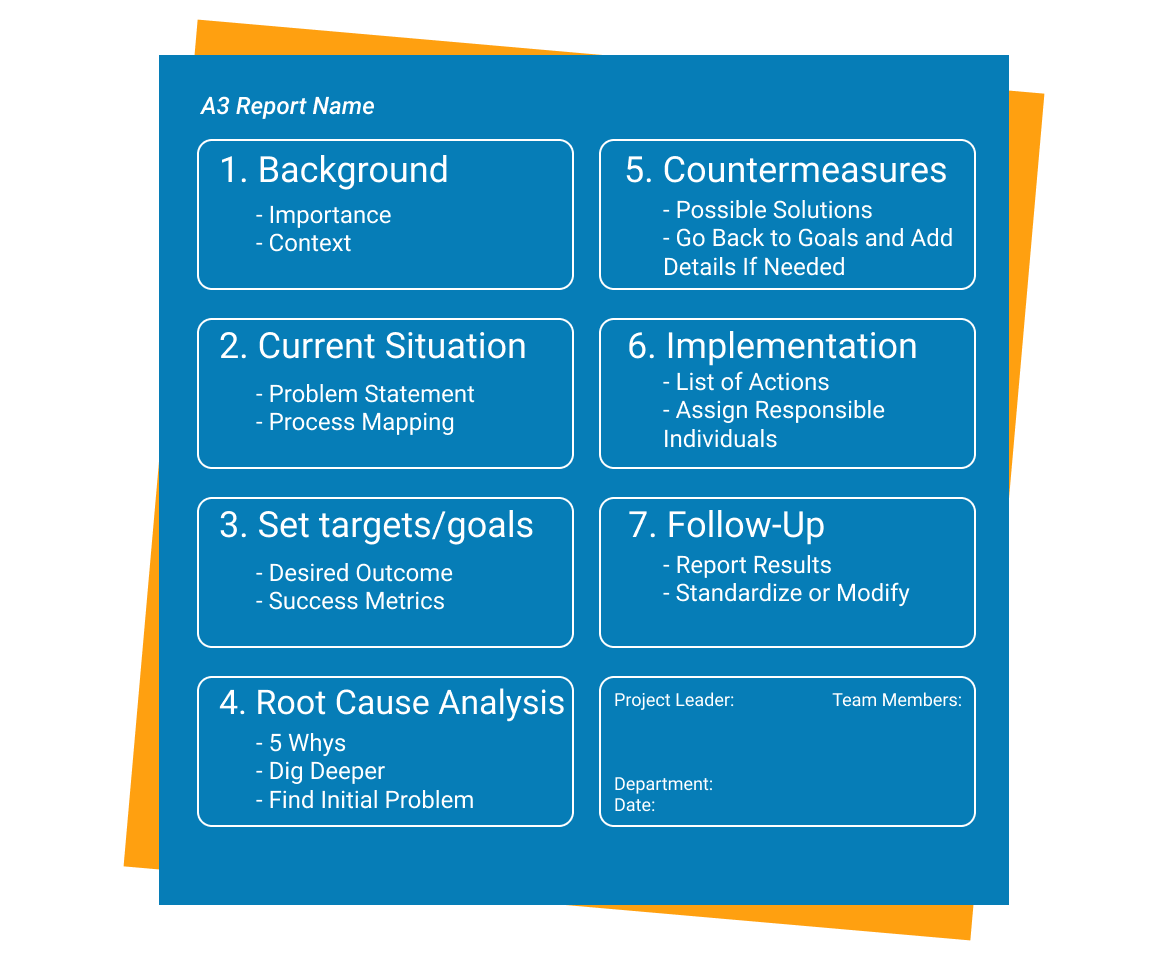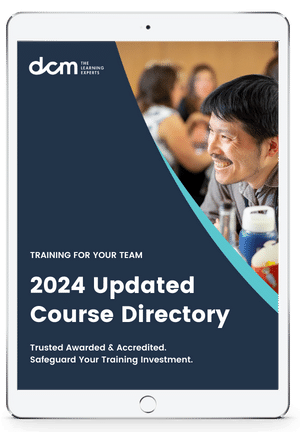A great part of our daily work routine is actually related to solving problems. Either small or big, problems are an inevitable part of our workday. However, if you decide to act fast and remove a problem as swiftly as possible, you may face the same issue over and over again.
Instead of fighting only the symptoms, you need to dig deeper and discover the root cause. By doing so, you will be able to protect the work process from recurring problems. This is where the A3 methodology comes into play.
Implementing an A3 problem-solving tool is a bright example of how problems should be treated in order to be eliminated efficiently. Based on some simple steps and ideas, the model gives directions on how to deal with problem-solving issues through simple structuring, good collaboration, and active communication.
What is A3 Thinking?
First of all, let’s briefly touch upon the mindset that A3 thinking aims to develop. It can be summarized in 7 elements:
1. Logical Thinking – A3 represents a step-based thinking process.
2. Presenting information in an objective way – there are no hidden agendas here.
3. Results and Processes – sharing what end results were achieved as well as the means of achieving them.
4. Sharing only essential information and putting it into a visual format whenever possible.
5. Whatever actions are taken, they must be aligned with the company’s strategy and objectives.
6. The focus is on developing a consistent perspective that can be adapted across the entire organization.
7. Developing a structured approach to problem-solving.
Origin of the A3 Problem-Solving Tool
The A3 report is one of the many Lean management tools, developed as part of the Toyota Production System (TPS).
There isn’t a single inventor of the A3 reporting method. In fact, Isao Kato (former manager at Toyota) describes it as a hybrid between the PDCA cycle and Toyota’s philosophy to make things visible.
There is also a legend that Taiichi Ohno often refused to read further than the first page of any written report. This is why the A3 is a one-page report.
The name A3 simply comes from the European A3 paper size corresponding to 11-inches by 17-inches or 29.7cm x 42cm.
A3 thinking played a major role in Toyota’s commercial success. Consequently, it became a widespread tool, now used in various industries.
Let’s explore the A3 problem-solving tool in details.
Foundations of the A3 model
Actually, A3 is just a single report that will not help you solve problems like a magic wand. It is much more important for all involved parties to be dedicated to the process itself and communicate actively.
Before you begin with the formation of your own A3 reporting method, you need to be familiar that there are 3 major roles in the process:
1. Owner
2. Responders
3. Mentor/coach
The owner is responsible for managing the process and maintaining the document. On the other hand, the owner needs to be advised and supervised by a mentor, who is experienced in problem-solving.
The mentor’s role is to give directions and provoke the problem owner to find the solution, but not to give answers and propositions.
Last but not least, there are responders or stakeholders. They are the third party, which is directly interested in the final results of the A3 project.
Here is the challenge. Usually, there is a wide variety of stakeholders involved. The problem owner needs to have access to all of them if needed.
However, we all know that in organizations with a strict hierarchy, it is a bit difficult to reach the higher management.
This is why the whole organization should be familiar with the concept of lean thinking and be prepared to assists at any time. Sometimes this is challenging, but it can show how flexible an organization really is.
At the end of the day, the active communication between all parties involved is crucial for the success of any A3 project.
The A3 Report
The A3 report is a single-page document, which reflects the results of the whole process. Usually, it contains seven steps, but it may also have other variations. Below you can find an A3 report example which most often will include the following steps:

- Background/Clarify the problem
- Current situation
- Set targets/goals
- Root cause analysis
- Countermeasures
- Implementation
- Effect confirmation/Follow-up
The A3 Process
The A3 methodology is a lean thinking process where the problem owner should go through the different steps of the model until there is a proper solution to be implemented. The owner needs to communicate actively with his colleagues and the mentor of the project.
Let’s now examine the different steps that comprise the A3 process.
Background
First of all, you need to clarify the problem and briefly describe it. This is a starting point where the owner can add context and support the next steps.
Current situation
Before a problem can be addressed properly, the problem owner needs to describe the current situation in the area where the issue appears.
At this stage, you can map the different processes that exist around the problem area. It will allow you to see the bigger picture and identify the root cause.
Set targets/goals
After the current situation is clear you need to set goals. Keep in mind that at this stage you need to take into consideration that you don’t have the full picture.
So after you go through the remaining steps until “effect confirmation” you can come back to this step and add more details to the initial goals.
Root cause analysis
This is a very important step from the successful implementation of the A3 process. Trying to fight the problem immediately means that you are only treating the symptoms while leaving the root cause untouched. This way a problem may appear regularly in bigger proportions.
Therefore, once you have a good understanding of how the processes work and what the initial goal is, you need to figure out the root cause of the problem. For this purpose, you can use different techniques such as the 5 whys.
Countermeasures
Once you are familiar with the root cause you may start offering solutions. From here you can go back to the initial goal and add more details. In all cases, the countermeasures should lead to a clear understanding of how the initial goal will be achieved.
Implementation Plan
After setting the countermeasures you have to present an implementation plan that includes a list of the actions that will be applied to get the countermeasures in place. It is also helpful to assign responsible individuals for each task and a due date.
Effect confirmation & Follow-up
The last step is crucial for establishing a culture of continuous improvement. It is very important to measure the actual results and confirm the effect of your countermeasures.
Whether there are positive or negative results you need to take actions.
If the actual results differ from the predicted ones, you should modify the plan, re-implement it, and follow-up. If there is a positive effect, you should communicate improvements to the rest of the organization and ultimately make them a standard.
Benefits of A3 problem-solving
The A3 model is consistent and it encourages mentoring and overall collaboration. Furthermore, it promotes the cross-organizational sharing of information and encourages learning and continuous improvement on every organizational level.
In addition, the A3 methodology encourages commitment to common goals and strengthens the levels of responsibility.
Last but not least, you can use an A3 report not only for problem-solving, but also for proposing improvements, reporting, coaching, and others.
In Summary
A3 is a useful problem-solving tool that has some significant advantages:
- It is simple and promotes mentoring and collaboration.
- It fights the root cause, but not only the symptoms.
- It encourages cross-organizational knowledge sharing.
- You can use the A3 report for a number of other things including reporting, coaching, proposing improvements, etc.
Source: Kanbanize
Inhouse Tailored Training for your Team
We provide training programs that are developed by industry, for industry. Our range of programs can be delivered in a way that suits the needs of your business to offer your employees learning that is accessible and flexible.
We add value to your business by providing specialised, flexible and scalable training that meets your training needs. As your workforce grows and evolves, our globally certified and industry-validated learning solutions can assess, train and qualify your employees. For more information on how we can help please visit the in-house training page.
Membership, Stay Connected. Stay Relevant.
Completing a program is a point-in-time exercise that delivers huge value, but there is a next step to maintaining the currency of your skills in the ever-evolving professional world.
Membership is the next step.
A unique platform, membership is designed to ensure that you are in tune and up-to-date with the latest tools, trends and developments. Being a member provides just-in-time training and continuous professional development, and an exclusive and evolving content library informed by subject matter experts and industry leaders.




_165x115_fc3.jpg)





